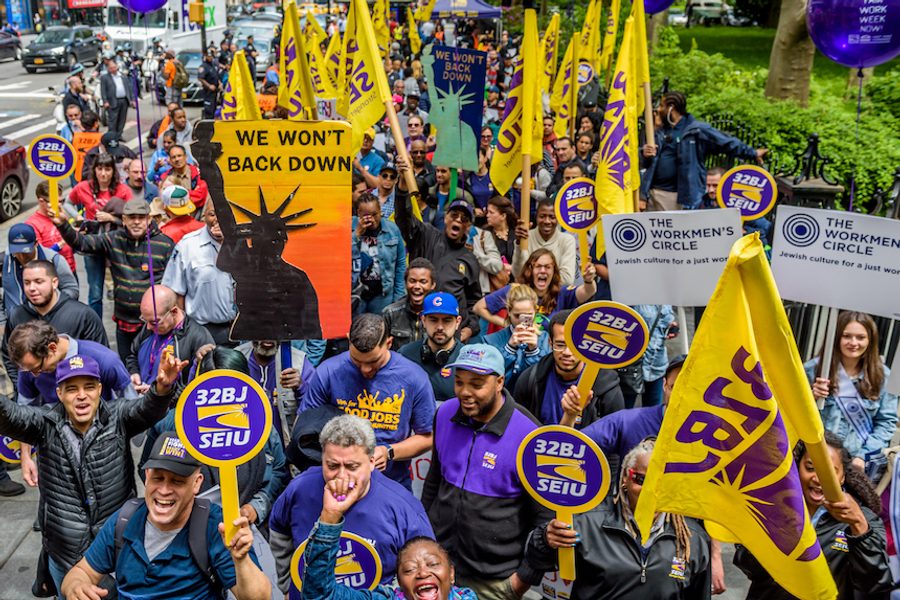Why We Always Cover Union Fights From the Perspective of Workers, Not Bosses
We’ve been covering the labor movement for decades. And we’re not quitting.
Jessica Stites

This month marks the 10th birthday of our continuing labor reporting project, Working In These Times. While In These Times has long been a champion of the union movement, WITT stepped it up with daily reporting at InTheseTimes.com. Our Golden Rule: Report from the perspective of workers, not bosses.
Reviewing some of the more than 4,500 stories, I am struck by the workers we’ve met. There’s former turkey plant worker Esmundo Juarez Carranza, fired for taking a bathroom break. “They treated us worse than animals,” he says.
There’s Samantha Rodriguez, who reported sexual harassment to her boss at a Walmart warehouse, only to have him ask her out. She says: “I pride myself on being an independent woman. I do remodeling, I hang drywall, I put in floors. … I went to warehouses because I like doing that kind of work. Now, I won’t step foot in a warehouse. I refuse to.”
There’s YMCA worker Linda Aguilar, who says: “The Y claims they want to ‘disrupt the cycle of poverty.’ But it’s not lost on me that they’re employing mostly Black and Brown women, and they’re paying them poverty wages.”
There’s Fight for $15 leader Douglas Hunter, a single father and $9.25-an-hour McDonald’s worker: “Many people thought we were crazy two years ago when we walked off our jobs in New York and demanded $15 an hour. They don’t think we’re crazy now.”
Corporate America has spent 50 years turning a weak labor law regime even more to its advantage. Democrats have done little to stop them, while Republicans cheer them on. U.S. union density has declined from 20.1% in 1983 to 10.5% today. That means 90% of workers are at the mer- cy of their bosses. Most can be fired at will.
Our original labor reporter, David Moberg, never one to be a Pollyanna, said organized labor was “stuck, but stirring” in 1976. In 2015, he wrote a piece titled, “Saving Labor’s Sinking Ship.”
But in reading the past 10 years of reporting, I see workers taking up the oars.
I became Working In These Times’ editor in 2012, a complete novice to the beat. (When reporter Bruce Vail talked about “the Fed,” I thought he meant the Federal Reserve, not the AFL-CIO.) Labor was riven by turf battles, like the notorious inter-union “nurse wars” in California. The innovative energy was in workers’ centers, which represented those hindered from unionizing by law: domestic workers, warehouse workers, restaurant workers, car-wash workers. The Chicago teachers were just about to walk out and the public launch of Fight for $15 was still four months away.
I never would have guessed that fast-food workers would make $15 a basic demand or that teachers in a dozen states would follow Chicago and walk out, not to mention that National Domestic Workers Alliance Director Ai-jen Poo would be Meryl Streep’s 2018 Golden Globes date.
Little of this activity, however, has increased union density, and the Supreme Court’s 2018 Janus decision chips away at public-sector unions, organized labor’s last bastion.
Perhaps we should instead focus on union propensity—the fighting union spirit, as old-school labor folks might say. WITT proves that spirit alive and well. A growing strike wave indicates a stirring. As the singer-organizer Joe Hill put it:
If the workers take a notion, they can stop all speeding trains / Every ship upon the ocean, they can tie with mighty chains / Every wheel in the creation, every mine and every mill / Fleets and armies of the nations, will at their command stand still.
David Moberg, forgive me, but I’ll say it: The labor movement is on the move. We look forward to introducing our readers to the workers who power it in the years to come.
Jessica Stites is Editor-at-large for In These Times.









